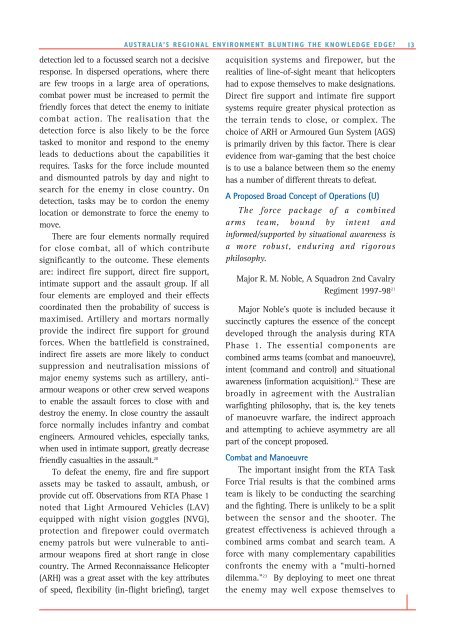ISSUE 150 : Sep/Oct - 2001 - Australian Defence Force Journal
ISSUE 150 : Sep/Oct - 2001 - Australian Defence Force Journal
ISSUE 150 : Sep/Oct - 2001 - Australian Defence Force Journal
Create successful ePaper yourself
Turn your PDF publications into a flip-book with our unique Google optimized e-Paper software.
AUSTRALIA’S REGIONAL ENVIRONMENT BLUNTING THE KNOWLEDGE EDGE? 13detection led to a focussed search not a decisiveresponse. In dispersed operations, where thereare few troops in a large area of operations,combat power must be increased to permit thefriendly forces that detect the enemy to initiatecombat action. The realisation that thedetection force is also likely to be the forcetasked to monitor and respond to the enemyleads to deductions about the capabilities itrequires. Tasks for the force include mountedand dismounted patrols by day and night tosearch for the enemy in close country. Ondetection, tasks may be to cordon the enemylocation or demonstrate to force the enemy tomove.There are four elements normally requiredfor close combat, all of which contributesignificantly to the outcome. These elementsare: indirect fire support, direct fire support,intimate support and the assault group. If allfour elements are employed and their effectscoordinated then the probability of success ismaximised. Artillery and mortars normallyprovide the indirect fire support for groundforces. When the battlefield is constrained,indirect fire assets are more likely to conductsuppression and neutralisation missions ofmajor enemy systems such as artillery, antiarmourweapons or other crew served weaponsto enable the assault forces to close with anddestroy the enemy. In close country the assaultforce normally includes infantry and combatengineers. Armoured vehicles, especially tanks,when used in intimate support, greatly decreasefriendly casualties in the assault. 20To defeat the enemy, fire and fire supportassets may be tasked to assault, ambush, orprovide cut off. Observations from RTA Phase 1noted that Light Armoured Vehicles (LAV)equipped with night vision goggles (NVG),protection and firepower could overmatchenemy patrols but were vulnerable to antiarmourweapons fired at short range in closecountry. The Armed Reconnaissance Helicopter(ARH) was a great asset with the key attributesof speed, flexibility (in-flight briefing), targetacquisition systems and firepower, but therealities of line-of-sight meant that helicoptershad to expose themselves to make designations.Direct fire support and intimate fire supportsystems require greater physical protection asthe terrain tends to close, or complex. Thechoice of ARH or Armoured Gun System (AGS)is primarily driven by this factor. There is clearevidence from war-gaming that the best choiceis to use a balance between them so the enemyhas a number of different threats to defeat.A Proposed Broad Concept of Operations (U)The force package of a combinedarms team, bound by intent andinformed/supported by situational awareness isa more robust, enduring and rigorousphilosophy.Major R. M. Noble, A Squadron 2nd CavalryRegiment 1997-98 21Major Noble’s quote is included because itsuccinctly captures the essence of the conceptdeveloped through the analysis during RTAPhase 1. The essential components arecombined arms teams (combat and manoeuvre),intent (command and control) and situationalawareness (information acquisition). 22 These arebroadly in agreement with the <strong>Australian</strong>warfighting philosophy, that is, the key tenetsof manoeuvre warfare, the indirect approachand attempting to achieve asymmetry are allpart of the concept proposed.Combat and ManoeuvreThe important insight from the RTA Task<strong>Force</strong> Trial results is that the combined armsteam is likely to be conducting the searchingand the fighting. There is unlikely to be a splitbetween the sensor and the shooter. Thegreatest effectiveness is achieved through acombined arms combat and search team. Aforce with many complementary capabilitiesconfronts the enemy with a “multi-horneddilemma.” 23 By deploying to meet one threatthe enemy may well expose themselves to
















